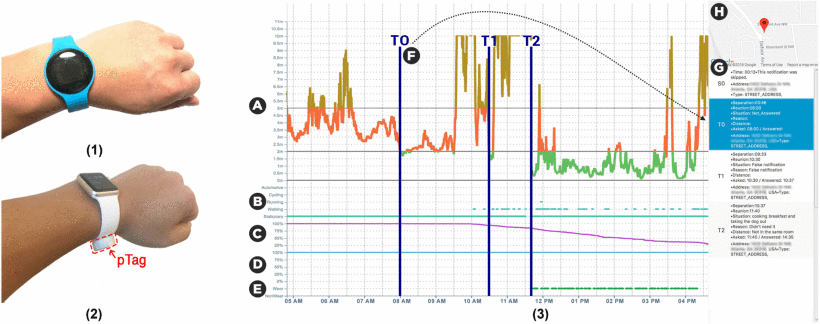Growing Apart: How Smart Devices Impact the Proximity of Users to Their Smartphones

Figure 1. (1) pBand. (2) pTag. (3) The data visualization tool, which presents one day of the study. (A) Proximity data in meters (0–2 m: light green, 2-6 m: orange, beyond 6 m: gold). (B) Motion status of the iPhone. (C) Battery level of the iPhone. (D) Battery level of pBand or pTag. (E) Dark green dots indicate the on-body status of pBand or Apple Watch. (F) Triggered or skipped EMA* notifications. (G) Details of the EMA notifications. (H) Location of the selected EMA in the list below. *EMA: Ecological Momentary Assessments
The widespread adoption of feature phones and smartphones has previously led researchers to test the assumption that users always have their phones ready at hand. We believe the current ubiquity of other smart devices has changed this.
Using a mixed methods approach inspired by past work in this area, we reevaluate the physical proximity relationship between individuals and their smartphone, as well as the role of other smart devices in users' lives. We find that, on average, participants have their phone within arm's reach 51% of the time, similar to the findings of the prior work. However, if smartphones are not within arm's reach, they are now much further away because of the use of wearables and other devices.
We also show how social, personal, and external factors result in users relying on other devices for functions (e.g., information seeking, checking the weather, setting timers and alarms, and playing music) once performed by their smartphones.
Measuring Proximity
Our proximity measuring protocol relied on a data gathering application on iPhone (Proximeter) and two Bluetooth Low Energy (BLE) devices—a Proximeter Tag (pTag) for people who had an Apple Watch and a Proximeter Band (pBand) for people who did not (see left side of Figure 1).
Proximeter collected location, motion, battery, and lock status of the phone and measured the received signal strength indication (RSSI) of the pBand or pTag every 10 s. All the collected data is displayed in a visualization tool (see right side of Figure 1).
User Study
- We recruited 17 iPhone users (average 30 years old / 11 females and 6 males / 9 Apple Watch users and 8 non-Apple Watch users.) and conducted a 4-week deployment study in Atlanta, USA.
- We conducted an additional online survey with 443 participants. Compared to our deployment participants, the survey respondents came from a wider range of demographics, had other mobile phone brands (e.g., Android) and device types (e.g., smartwatches, smart speakers).
Results
On average, participants had their phone within arm's reach 51% of the time. However, in comparing proximity within the same room, we found significant changes. Dey et al. reported that this occurred 35% of the time while we found it had decreased to 14%. Our data suggests this is due to the introduction of smart devices, which offset the need to have the phone in the same room as tasks can be accomplished without the phone.

Comparison of the smartphone proximity measure in our field deployment study with two previous studies.
Patel et al. and Dey et al. examined the smartphone proximity in 2006 and 2011, respectively
Factors That Affect Proximity
In our paper, we provide a comparison of the affecting factors we uncovered with those originally found in Dey and Patel's study. For more information, please refer to our paper published in IEEE Pervasive Computing Magazine.
